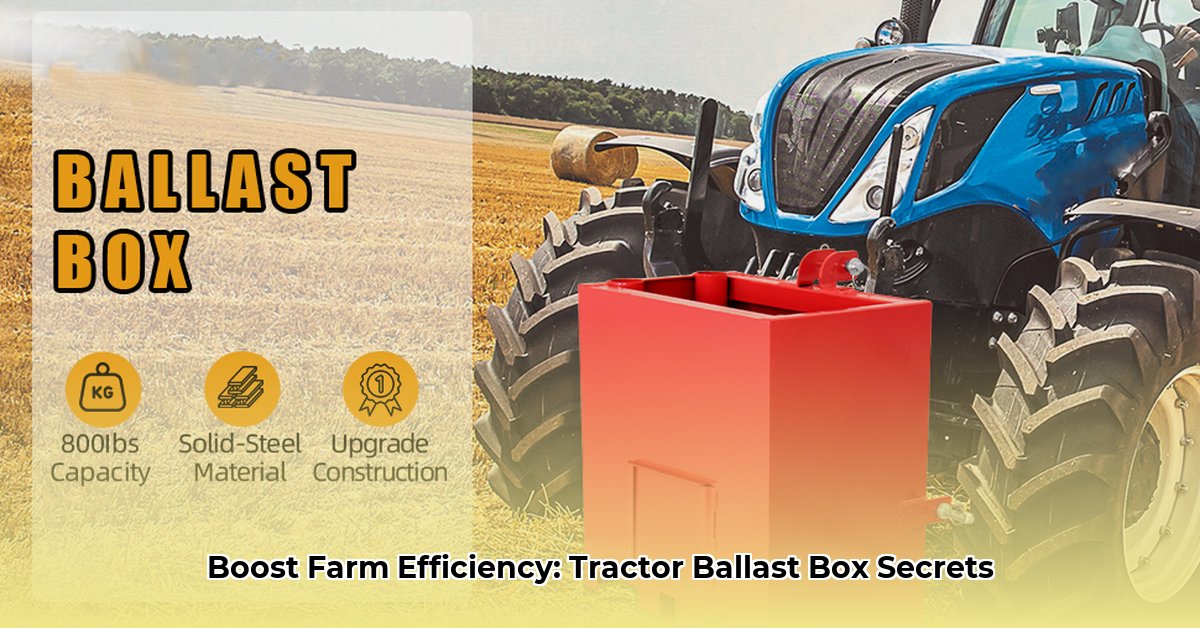
Understanding Ballast Boxes and Their Role in Sustainable Farming
Ballast boxes are more than just heavy containers; they're essential tools for boosting the efficiency and sustainability of your compact tractor operations. By adding significant weight to your tractor, they dramatically improve traction, especially crucial on challenging terrain or during demanding tasks like plowing heavy soil or clearing snow. This enhanced stability leads to several key benefits: reduced wheel slippage translates to lower fuel consumption, decreased wear and tear on your tractor's components, and ultimately increased productivity. Wouldn't you agree that maximizing efficiency is key to effective and sustainable farming? For more information on tractor supplies, check out this helpful resource: Tractor Supply Guide.
Types of Ballast Boxes Available at Tractor Supply
Tractor Supply offers a variety of ballast boxes, each with its own strengths and weaknesses. Choosing the right one depends on your specific needs, budget, and the type of work you'll be doing. Let's examine the common options:
| Feature | Steel Ballast Box | Liquid-Filled Ballast Box | Cast Iron Ballast Box |
|---|---|---|---|
| Weight Capacity | High (50-500+ lbs) | Variable (depending on fluid volume) | High (100-800+ lbs) |
| Material | Steel | Steel or Plastic (with liquid fill) | Cast Iron |
| Durability | High (but susceptible to rust) | Moderate (potential for leaks) | Excellent (very resistant to wear) |
| Cost | Relatively Inexpensive | Moderate | Significantly More Expensive |
| Maintenance | Requires regular cleaning and painting | Requires careful fluid level monitoring | Minimal maintenance required |
| Best Use Cases | General farm tasks, most soil types | Situations needing precise weight adjustments | Heavy-duty tasks, demanding conditions |
A crucial factor to consider is the weight capacity of each type. "Overloading your tractor can cause significant damage and safety hazards," reminds Dr. Amelia Hernandez, Agricultural Engineering Professor at the University of California, Davis. Therefore, always consult your tractor's owner's manual for weight limits.
Choosing the Right Ballast Box: A Step-by-Step Guide
Selecting the perfect ballast box involves a strategic approach. Consider these steps:
Consult Your Tractor's Manual: Determine the maximum allowable weight your tractor can safely support. This is non-negotiable for safe operation.
Analyze Your Farming Needs: What tasks will the ballast box primarily support? Heavy plowing demands a heavier box than light mowing.
Set a Realistic Budget: Steel boxes are more affordable; cast iron offers superior durability but comes at a higher price. Weigh the long-term cost benefits against immediate expenses.
Compare and Contrast: Use the table above to carefully evaluate the pros and cons of each type in relation to your specific needs.
Read Online Reviews: Before purchasing, research user reviews to gain insight into the real-world performance and durability of different models. Online forums and Tractor Supply's website are valuable resources.
Did you know that a properly weighted tractor can reduce fuel consumption by up to 15%? This is a significant cost saving in the long run.
Installing and Using Your Ballast Box Safely
Installing a ballast box typically involves attaching it to your tractor's three-point hitch. Always follow the manufacturer's instructions precisely; deviations can compromise safety. Remember these key points:
Engage the Parking Brake: Always engage the parking brake before mounting or dismounting the ballast box.
Secure Attachments: Ensure all attachment points are securely fastened. Loose connections present a significant safety hazard.
Adjust to Increased Weight: Be aware that the added weight alters your tractor's handling characteristics. Operate cautiously.
Maintaining Your Ballast Box for Long-Term Use
Regular maintenance is essential for extending the lifespan of your ballast box and maximizing your return on investment.
Periodic Cleaning: Clean the box regularly to remove mud, dirt, and debris. This prevents corrosion (especially crucial for steel boxes) and allows for easy detection of damage.
Thorough Inspections: Regularly inspect for cracks, rust, leaks, or any signs of damage. Address these issues promptly to prevent further deterioration.
Appropriate Storage: When not in use, store the ballast box in a dry, protected environment to prevent rust and corrosion.
Sustainability Considerations: Minimizing Environmental Impact
While ballast boxes aren't inherently "eco-friendly," their use promotes fuel efficiency, thus indirectly reducing your environmental footprint. Responsible disposal practices, such as recycling or reselling, are key to minimizing the long-term environmental impact. Furthermore, future innovations and research may produce ballast boxes created from more sustainable materials.
Conclusion: A Smart Investment for Sustainable Farming
Investing in a well-chosen ballast box from Tractor Supply represents a strategic move toward a more efficient and sustainable farming operation. The enhanced traction, fuel efficiency, and extended equipment lifespan contribute to both economic and environmental benefits. It's a sound investment that pays dividends over time.